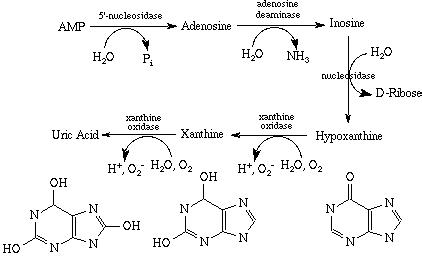Page created on March 30, 2019. Last updated on December 18, 2024 at 16:57
General
The metabolism of nucleic acid involves breaking them down into pyrimidines or purines. The metabolism of purines (like AMP, IMP and GMP) is the most clinically important.
Breakdown of purines involves breaking them down to uric acid (or urate) with the enzyme xanthine oxidase. Uric acid is poorly water soluble and is therefore prone to crystallize. Normal plasma level of uric acid is 6.4 mg/dL. The plasma is saturated at 7.0 mg/dL, and uric acid begins to precipitate at around 9 mg/dL. Uric acid is excreted mostly through the kidney.

Purine metabolism
Approx. half of the daily urate gain is exogenous (from food) and the other half is endogenous (from breakdown of purines). Nuts and liver are foods that have especially high content of purines.
The level of uric acid in the body can increase due to:
- Increased uric acid production
- States of enhanced cell proliferation or destruction
- Leukaemia
- Necrosis
- Haemolysis
- Hypoxia
- Obesity
- Alcohol consumption – alcohol enhances the function of xanthine oxidase
- States of enhanced cell proliferation or destruction
- Decreased uric acid excretion
- Low GFR (renal failure)
- Alcohol consumption – alcohol metabolites compete with uric acid transporters in the kidney
- Certain medications
Gout
Gout is a metabolic disease that occurs due to increased body pool of uric acid. It is characterized by episodes of acute painful arthritis caused by precipitation of sharp sodium-uric acid crystals in joints. Joints of the big toes are most frequently affected, a condition called podagra. Nephrolithiasis and tophus are also frequent. Acute gouty attacks may be caused by alcohol consumption and big meals.
Gout is associated with diabetes mellitus, metabolic syndrome and anaemia.
Precipitation of uric acid is related to hyperuricaemia, but even extremely high levels of uric acid don’t necessarily cause precipitation. This indicates that other factors may be involved in precipitation. Indeed, decreased temperature and pH increase the risk for precipitation, which may explain why it usually occurs in the big toe joint.
A tophus (plural: tophi) is a painless nodular mass that consist of uric acid crystals that is surrounded by fibrosis and macrophages. These occur in soft tissue or the bones. Google it; they look horrible.
Gout is treated by many different drugs:
- Allopurinol – inhibits xanthine oxidase
- Colchicine – inhibits the activity of leukocytes and inflammation
- Glucocorticoids
Treatment also involves purine-restricted diet, low in nuts, liver and meat and weight loss.